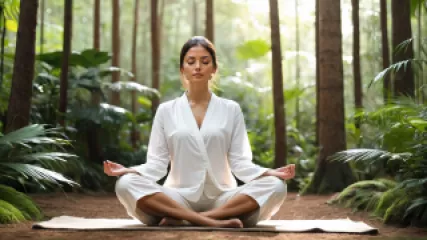Mindful Exercises to Enhance Concentration
Unlock Your Mental Potential: Mindful Exercises to Enhance Concentration
In today's fast-paced world, where distractions abound and attention spans wane, the ability to focus and concentrate has become an invaluable skill. Whether you're a student tackling complex coursework, a professional juggling multiple projects, or simply an individual seeking to optimize your cognitive performance, developing and maintaining a sharp, focused mind can be a game-changer. In this comprehensive guide, we'll explore a range of mindful exercises and techniques that can help you boost your mental focus, improve your concentration, and unlock your full cognitive potential.
The Importance of Concentration in Today's World
In an age of constant digital stimulation and information overload, the ability to focus and concentrate has become increasingly challenging. From the endless scrolling of social media to the constant pings and notifications of our devices, our attention is constantly being pulled in multiple directions. This fragmentation of focus can have far-reaching consequences, affecting our productivity, our decision-making abilities, and even our overall well-being.
However, the good news is that concentration and focus are not fixed traits. They are skills that can be cultivated and honed through deliberate practice and the implementation of mindful strategies. By incorporating specific exercises and techniques into our daily routines, we can train our minds to become more attentive, focused, and resilient in the face of distractions.
Understanding the Science of Concentration
At the heart of concentration lies the concept of attention. Attention is the cognitive process by which we selectively focus on specific stimuli or information, filtering out the myriad of other inputs vying for our mental resources. This selective focus is essential for effective problem-solving, decision-making, and task completion.
Neuroscientific research has shown that the ability to concentrate is closely tied to the functioning of the prefrontal cortex, the region of the brain responsible for higher-order cognitive functions such as planning, decision-making, and impulse control. When we engage in mindful exercises that promote concentration, we're actively strengthening the neural pathways and connections within this crucial brain region.
Furthermore, studies have demonstrated that regular mindfulness practice can lead to structural changes in the brain, increasing the thickness of the prefrontal cortex and enhancing its overall efficiency. This neuroplasticity, the brain's ability to adapt and change in response to experience, is the foundation upon which we can build our concentration skills.
Cultivating Concentration Through Mindful Exercises
Now that we've explored the science behind concentration, let's dive into the practical steps you can take to enhance your focus and attention through mindful exercises. Remember, developing and maintaining a strong concentration is a journey, not a destination, and the more consistent you are with these practices, the more profound the benefits will be.
1. Mindful Breathing
One of the most fundamental and powerful mindful exercises for improving concentration is the practice of mindful breathing. By bringing your attention to the sensations of your breath, you can anchor your mind in the present moment, reducing the mental chatter and distractions that often plague us.
To begin, find a quiet and comfortable place to sit. Close your eyes (or keep them gently open, with a soft gaze) and turn your attention to your breath. Notice the sensation of the air moving in and out of your nostrils, or the gentle rise and fall of your abdomen. If your mind wanders, gently bring your focus back to your breathing.
Start with just 5-10 minutes of mindful breathing per day, and gradually increase the duration as you become more comfortable with the practice. Consistent practice of mindful breathing can help train your mind to become more focused, attentive, and resilient in the face of distractions.
2. Body Scan Meditation
Another effective mindful exercise for enhancing concentration is the body scan meditation. This practice involves systematically directing your attention to different parts of your body, cultivating a heightened awareness of the physical sensations you experience.
Begin by sitting or lying down comfortably. Close your eyes (or keep them gently open) and start by focusing your attention on your feet. Notice any sensations, such as warmth, tingling, or heaviness. Slowly work your way up through your body, directing your focus to your calves, thighs, hips, abdomen, chest, back, hands, arms, shoulders, neck, and finally, your face and head.
As you move your attention through your body, be present with each area, observing the sensations without judgment or attachment. If your mind wanders, gently bring it back to the current area of focus. This practice can help you develop a greater sense of bodily awareness and the ability to maintain focus, both of which are essential for enhancing concentration.
3. Focused Attention Meditation
The focused attention meditation is a powerful technique for training your mind to stay present and concentrated on a single object or point of focus. This exercise can be particularly helpful for individuals who struggle with a wandering or restless mind.
Begin by choosing a single point of focus, such as a candle flame, a flower, or a mantra. Sit comfortably and direct your full attention to this object or phrase. As thoughts arise, gently redirect your focus back to the point of concentration. If you find your mind drifting, don't be discouraged – simply acknowledge the distraction and return your attention to the object of focus.
Start with short sessions of 5-10 minutes and gradually increase the duration as you become more proficient. Consistent practice of focused attention meditation can help you develop the ability to maintain a laser-like focus, even in the face of distractions.
4. Mindful Walking
While seated meditation practices are beneficial for enhancing concentration, incorporating mindful walking into your routine can also be a powerful tool. This exercise allows you to cultivate present-moment awareness while engaging in a physical activity.
Find a quiet, peaceful place to walk, such as a park or a natural setting. As you begin to walk, bring your attention to the sensations in your body – the feeling of your feet touching the ground, the rhythm of your steps, the movement of your arms, and the sensation of the air on your skin. If your mind wanders, gently guide it back to the present moment, focusing on your physical sensations and the act of walking itself.
Mindful walking can be particularly helpful for breaking up long periods of sedentary work or study, providing a refreshing respite and an opportunity to reset your focus and attention.
5. Journaling and Reflection
While the previous exercises have focused on cultivating concentration through meditation and physical practices, journaling and reflection can also be a powerful tool for enhancing your focus and attention.
Set aside time each day to write in a journal, reflecting on your experiences, thoughts, and emotions. This practice can help you gain greater self-awareness and clarity, allowing you to identify distractions and barriers to concentration. Additionally, regularly reviewing your journal entries can help you track your progress and identify patterns in your attention and focus habits.
You can also use journaling as a way to set intentions and goals related to improving your concentration, and then reflect on your successes and challenges along the way. The act of putting pen to paper can help solidify your focus and commitment to enhancing your cognitive abilities.
Integrating Mindful Exercises into Your Daily Routine
Developing a consistent practice of mindful exercises is key to unlocking the full benefits of enhanced concentration. Incorporate these techniques into your daily routine, even if it's just for a few minutes at a time. The more you make concentration-boosting exercises a habit, the more effortless and impactful they will become.
Start by choosing one or two exercises that resonate with you the most and commit to practicing them regularly. As you become more comfortable, you can gradually introduce additional mindful practices into your routine. Remember, the journey of enhancing your concentration is a lifelong one, and the more you invest in it, the more you'll reap the rewards.
Conclusion: Unleash Your Cognitive Potential
In today's fast-paced, attention-demanding world, the ability to boost your mental focus, improve your concentration, and unlock your full cognitive potential has become a valuable and sought-after skill. By incorporating mindful exercises such as mindful breathing, body scan meditation, focused attention meditation, mindful walking, and journaling into your daily routine, you can train your mind to become more focused, resilient, and efficient.
Embrace this journey of self-discovery and cognitive enhancement. Consistent practice of these mindful techniques will not only improve your ability to concentrate but also positively impact your overall well-being, decision-making, and productivity. Unlock the full power of your mind and embark on a path of greater focus, clarity, and success.
Key Takeaways:
- Concentration and focus are essential skills in today's world, but can be cultivated and honed through mindful exercises.
- The science behind concentration is linked to the functioning of the prefrontal cortex, which can be strengthened through regular mindfulness practice.
- Mindful exercises such as breathing, body scans, focused attention, walking, and journaling can all contribute to enhancing your concentration and cognitive abilities.
- Consistency is key – incorporating these mindful practices into your daily routine is the best way to unlock the full benefits of improved focus and attention.
- Embracing this journey of self-discovery and cognitive enhancement can lead to greater well-being, productivity, and success in all areas of your life.
Remember, the journey of enhancing your concentration is a lifelong one, and the more you invest in it, the more you'll reap the rewards. Embrace the challenge, trust the process, and watch as your cognitive potential unfolds before you.






